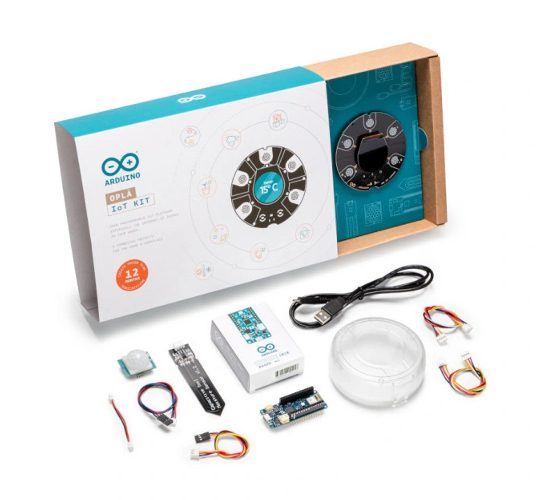Table of Contents:
Today we get to know more about Arduino MKR family of boards including those with specific IoT applications.
For a good start: it’s good that we get a chance to take this into account just at the occasion of the Arduino MKR series. Some of the boards have some visual imperfections, the genesis of which is quite ordinary – the Italian manufacturer adjusted the board settings at an early stage of design. You can find the same annotation on product pages of Botland store.
Botland is an official distributor of Arduino programming platform. We provide countless main units, modules and accessories of this popular brand as well as tutorials and know-how base. Our team ensures that all provided Arduino products are original.
Let’s finally move on to one of the most popular Arduino series, which, following in the footsteps of the recommended Arduino Uno for beginners (we’ll probably mention it later), will work well in the hands of even novice DIYers and designers.
Who was the Arduino MKR created for?
The Arduino MKR family was created for developers and engineers to rapidly prototype IoT projects. What sets MKR boards apart from other Arduino boards is the size, integrated connectivity in most of them, and the potential for projects of varying degrees of sophistication.
Opening Arduino MKR Family Tree
MKR boards have built-in connectivity modules from Wi-Fi to GSM – well, with one exception, Zero. Other boards support narrowband IoT, Lo-Ra connectivity and SigFox (for chosen countries), while Arduino MKR shields can be added to create Ethernet and CAN (controller area network) connected designs.
It’s worth noting the difference, which will be noticeable even to the untrained in electronics observers. Compared to the popular, original Arduino Uno module, presented MKR boards are much smaller. However, we have the standard relay, memory and prototype shields available here, as well as some more advanced shields.
Let’s dispel doubts about compatibility. Does the MKR get along with its nearest neighbors? Yes. This is helped by pinout expanders such as the MKR2Uno connector adapter, an overlay for Arduino MKR, which allows us to use MKR boards in projects designed for Arduino Uno. It also allows you to use overlays.

Start ahead. Arduino MKR1000
There’s a reason this is the model that opens the Arduino Getting Started tutorials. The MKR1000 board is designed as a practical and cost-effective solution for those looking to add Wi-Fi connectivity to their projects with minimal prior networking experience. You can set up your development environment and have your hardware ready to work on projects in just a few minutes.
The MKR1000 is programmed using the Arduino IDE software, an integrated development environment common to all Arduino boards and working both online and offline. You can read more about the environment itself under article tile below.

So we can use this and other boards with:
- Arduino IDE desktop versions – downloaded directly,
- Arduino IoT Cloud – services from Arduino in the cloud,
- Arduino Web IDE – all Arduino boards, including MKR1000, also work in the online editor.
Curios: Arduino MKR Zero & Arduino MKR Vidor 4000
We list these two tiles side by side as interesting because of certain features.
Arduino MKR Zero
Currently, the only MKR board without built-in connectivity is the Arduino MKR Zero. It’s primarily a good choice for those who already have experience with an Arduino Uno board based on an 8-bit microcontroller, and want to start learning the ins and outs of hardware and software embedded systems with 32-bit microcontrollers.

MKR Zero has 256 KB Flash memory, 32 KB SRAM, 22 digital I/O, 12 PWM channels, 7 analog inputs & 1output, microSD card slot, Lipol battery power and popular interfaces. It operates with a voltage of 3.3 V. It supports I2S interface and can play audio files without additional hardware. See the product page for detailed specifications and valuable notes.
Arduino MKR Vidor4000
A rather exotic name at first glance hides the first board based on a programmable FPGA chip. Vidor is based on Intel’s Cyclone 10 chip with 16,000 logic units. There are 2 MB Flash memory, 8 MB SRAM, U-blox Nina-W10 module for WiFi and BT connectivity. Operating at 3.3 V, a solid proposition for your own Internet of Things projects.

Before you look at the full technical specifications, a word about the connectors on board the Arduino MKR Vidor4000 board. At our disposal is such a set:
- MicroUSB,
- MicroHDMI,
- 3.7V battery connector,
- MIPI camera connector,
- Mini PCI Express connector.
Due to their extended capabilities, both the MKR Zero and Vidor 4000 are intended for more advanced Arduino users. The MKR Zero performs flawlessly in audio projects thanks to its integrated I2S bus and miniSD card slot, while the Vidor model is praised for its fast audio and video processing. Other projects that take advantage of MKR’s compact board size and powerful ICs include robotics.
Reaching far with LoRaWAN. Arduino MKR WAN 1310
The MKR WAN 1310 is an example of a module with an Atmel ARM Cortex-M0+ 32-bit microcontroller that enables LoRa network connectivity. This standard, which is gaining popularity, is a radio communication characterized by low power consumption and relatively long range, thus offering slick communication for IoT devices.
As a side note: we have mentioned LoRaWAN, or LoRa for short, many times, but probably most often in the context of solutions for farmers and smart cities. This protocol and communication system works especially well where devices providing data and performing specific tasks are often simply physically distant from each other.
What does the WAN 1310 offer? External Flash memory 2 MB, Flash 256 KB, SRAM 32 KB, support for UART, SPI, I2C interfaces, 12 PWM pins, 8 digital I/O pins. And as always, for you to know where to look – we’ve written tech specs and notes on the product page, so check it.
Assimilated into the family – Arduino OPLÁ (OPLA)
In keeping with the theory that the best should be left for last. OPLA’s Arduino Starter Kit with a sharp touch – we pronounce it ascending as if we want to cover the distance to the Internet of Things in our own home or office in one leap. And that is exactly what is possible with the Arduino OPLA Starter Kit.
Arduino OPLA the first IoT development platform that allows you to create your own devices with full control over their algorithms and your own data.
The kit was included in the article for two reasons – and those two reasons are the two MKR series boards included. The first is the Arduino MKR 1010, which is the newer, improved generation of the MKR 1000 discussed earlier. The WiFi module on the MKR 1010 has been upgraded to ESP32, giving not only wifi connectivity, but also Bluetooth. The board is also fully compatible with the Arduino IoT Cloud. The second item is even more interesting. This is the real heart of the kit, at the development stage referred to as the Opla Board – we are talking about the MKR IoT Carrier Board, and this is already a real board-polygote with wide compatibility and a multifunctional center for the Internet of Things.

Algorithms sound complicated, yes, but they are not necessary. After all, a personal computer can also be used to play Microsoft Solitaire or to code – it all depends on the user and the preferred tools. In the Arduino OPLÀ IoT kit, there are eight sample and almost finished projects waiting for us. The first half is ready to install at home, the others will serve to understand what IoT is in general and what it offers us.
We can’t get past the Arduino MKR IoT Carrier Board module without at least a few sentences. This extension for the MKR series Arduino modules gives you unlimited possibilities in your IoT projects – worth mentioning, without the need for soldering.

It features an OLED display, touch buttons, Grove connectors (so there’s compatibility, good news for us), temperature and humidity, IMU, light, gesture, and distance sensors, as well as a buzzer, relay connectors, a microSD card slot, an RGB LED, and a Li-Ion battery clip. Data read from the sensors can be displayed on the display and uploaded to the Arduino IoT Cloud.
Small-scale IoT development boards are proof of the growing popularity, and even necessity, of cloud-based electronics & smarthome projects. Using the right schematics that translate into design assumptions, add-ons and communication methods makes it possible to create truly powerful, fully-connected ideas made real. With a bit of searching, you can find options for developers of varying experience, as well as for seasoned prototyping engineers. You’re sure to find all of this among the fruits of the MKR series.
How useful was this post?
Click on a star to rate it!
Average rating 0 / 5. Vote count: 0
No votes so far! Be the first to rate this post.



















